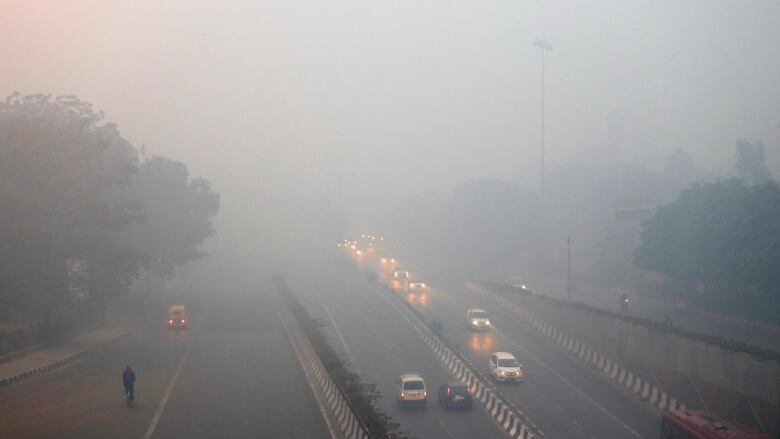New Delhi residents urged to stay indoors as pollution rate skyrockets
City recording particulate matter readings Monday 90 times higher than World Health recommendation

As Indians wake Monday to smoke-filled skies from a weekend of festival fireworks, New Delhi's worst season for air pollution begins with dire consequences.
A new report from UNICEF says about a third of the two billion children in the world who are breathing toxic air live in northern India and neighbouring countries, risking serious health effects including damage to their lungs, brains and other organs. Of that global total, 300 million kids are exposed to pollution levels more than six times higher thanstandards set by the World Health Organization, including 220 million in South Asia.
For the Indian capital, the alarming numbers are hardly a surprise. New Delhi's air pollution, among the world's worst, spikes every winter because of the season's weak winds and countless garbage fires set alight to help people stay warm.

Even days before the city erupted in annual fireworks celebrations for the Hindu holiday of Diwali, recorded levels of tiny, lung-clogging particulate matter known as PM 2.5 on Friday were considered dangerous at well above 300 micrograms per cubic metre. By Monday morning, the city was recording PM 2.5 levels above 900 mcg per cubic metre more than 90 times higher than the WHO recommendation of no more than 10 mcg per cubic metre.
"My eyes are irritated, I'm coughing and I find it difficult to breathe," said 18-year-old Delhi student Dharmendra, who uses only one name as is common in India. Because of the pollution, "I don't go out so much nowadays."
New Delhi residents were advised to stay indoors on Monday, with health warnings issued for the young, elderly and those with respiratory or heart conditions. Officials said the high pollution levels were made worse by the ongoing burning of spent crops in agricultural fields in the neighbouring states of Punjab and Haryana.
"Pollution levels every winter gallop, and we are already beginning to see the signs of it," said Anumita Roy Chowdhury, executive director of the Centre for Science and Environment, a Delhi-based research and lobbying organization. Some local studies indicate up to a third of Delhi's children have impaired lung function and respiratory diseases like asthma, she said. "This really signals health disaster."
Construction dust, kerosene fires contribute
Children face much higher health risks from air pollution than adults. Children breathe twice as quickly, taking in more air in relation to their body weight, while their brains and immune systems are still developing and vulnerable.
"The impact is commensurately shocking," with 600,000 children younger than 5 across the world dying every year from air pollution-related disease, UNICEF Executive Director Anthony Lake said in the report released Monday. "Millions more suffer from respiratory diseases that diminish their resilience and affect their physical and cognitive development.

Of the two billion children worldwide breathing unhealthy air, the report puts 620 million of them in South Asia - mostly northern India. Another 520 million children are breathing toxic air in Africa, and 450 million in East Asia, mainly China, according to the report, which combined satellite images of pollution and ground data with demographic patterns to determine which populations fell into the highest risk areas.
- Pollution cited as factor in plunging wildlife rates
- Energy group links 6.5 million deaths annually to air pollution
Since being identified as one of the world's most polluted cities in recent years, New Delhi has tried to clean its air. It has barred cargo trucks from city streets, required drivers to buy newer cars that meet higher emissions standards and carried out several weeks of experimental traffic control, limiting the number of cars on the road. But other pollution sources including construction dust and cooking fires fuelled by wood or kerosene continue unabated.
Last week, the city launched a smartphone application called "Change the Air" inviting residents to send photos and complaints about illegal pollution sources, from the burning of leaves and garbage in public parks to construction crews working without dust control measures.












_(720p).jpg)


 OFFICIAL HD MUSIC VIDEO.jpg)
.jpg)



























































































